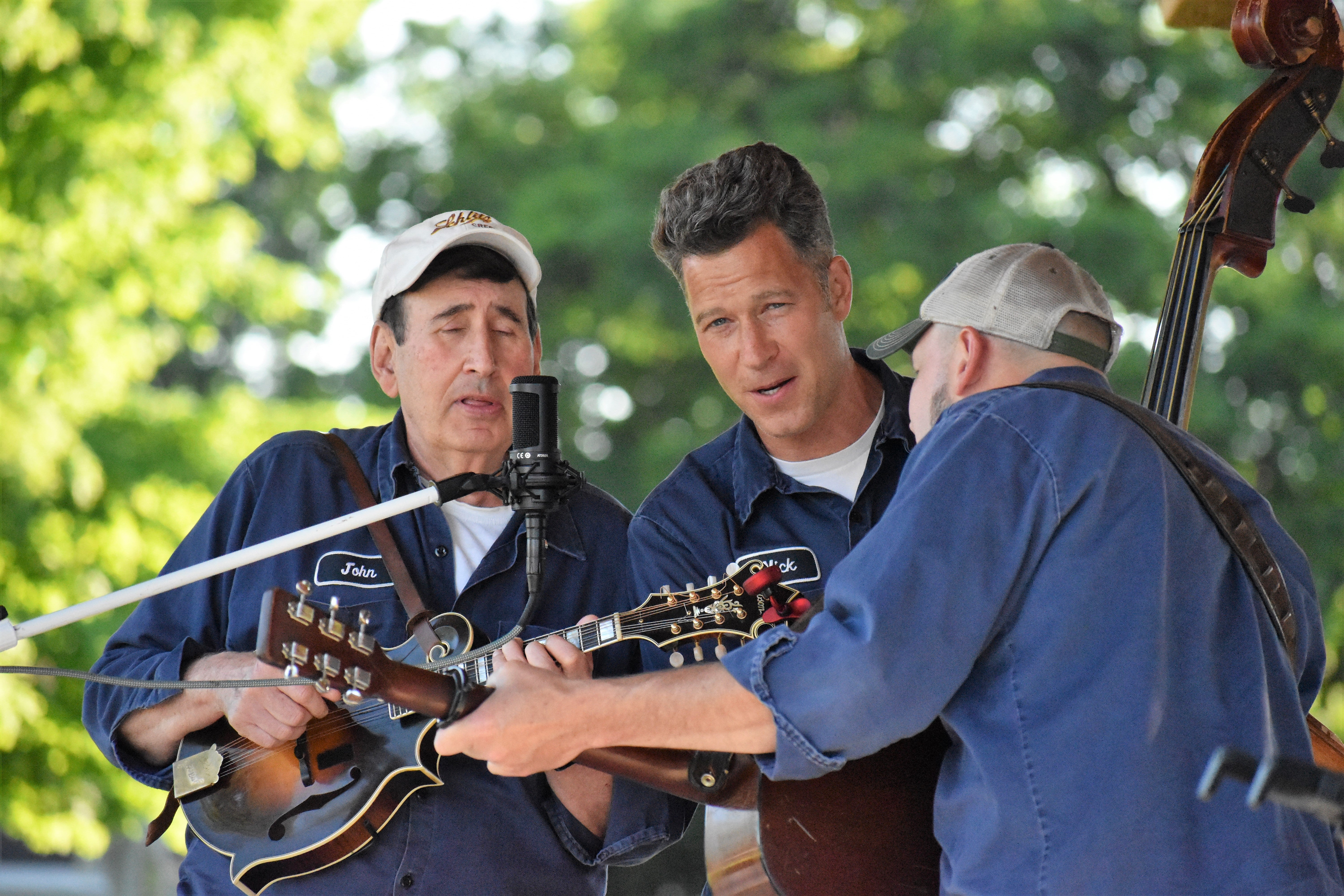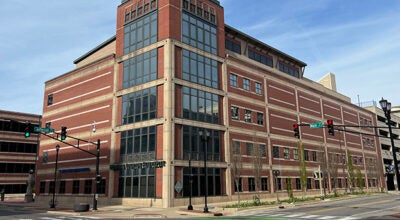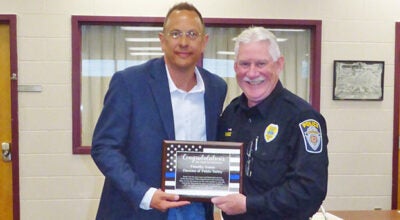Prison spending gobbling budget
Published 10:18 pm Thursday, August 18, 2011

Cass County Prosecutor Victor Fitz and Assistant Prosecutor Diab Rizk at Dowagiac Rotary Club Aug. 18. (The Daily News/John Eby)
Michigan could save hundreds of millions of dollars by getting corrections costs in line with other states, Cass County Prosecutor Victor Fitz told his fellow Dowagiac Rotarians Thursday noon at Elks Lodge 889.
Midwest states spend an average $25,789 per incarcerated prisoner, from $16,432 in Missouri and $19,812 in Indiana to $32,766 in Minnesota and $32,817 in Michigan.
Michigan could save $309.2 million per year spending the average.
The Department of Corrections budget hovered around $2 billion even after the prison population shrank by 13 percent and five prisons and six camps closed.
Spending increased 538 percent in the last 34 years in Michigan.
DOC spending accounted for 20 percent of the general fund budget, up from 5 percent in 1983, with a third of state employees assigned to that department.
“Our mantra to the new director of the Department of Corrections is we want to work hard with you, but not at the expense of doing away with truth in sentencing or public safety. Cut where money can be cut and not just take the easy, lazy solution of letting people out the back door who should never be let out,” Fitz said.
Gov. Rick Snyder in June appointed Daniel Heyns to administer the $1.9 billion budget. Heyns brought more than 34 years in law enforcement, including eight years as Jackson County sheriff.
“Something you’ll see in the coming days as you watch this argument is length of stay. They’ll say Michigan is disproportionate to other states. We keep our prisoners in longer, so we’ve got to lower that length of stay. Well, that is not an apples to apples comparison. Other states send four out of 10 to prison, we send two. Other states send home invaders, forgers, who don’t get sentences as high. Our two out of 10 felons going to prison are probably going to be getting that 17-year sentence. Other states sending four, two of them are murderers and two of them are perhaps forgers who are getting two years in prison. You do the average, that other state has a lower length of stay, but that’s because they are less violent. That’s another way to bait and switch. If they’re in there a long period of time, it’s because they did something terrible to merit that length of stay.”
Fitz’s presentation was a continuation of a two-part program on last September’s Prosecuting Attorneys Association of Michigan (PAAM) Corrections Committee report.
Heyns will be speaking at PAAM’s summer conference. “We’ve met with him once already and we’re cautiously optimistic,” Fitz said. “He indicated he can only hire five people. The rest are civil service.”
Michigan’s constitution mandates that the purpose of state government is security and protection of its people.
“For obvious reasons,” Fitz said. “If your community isn’t safe, businesses won’t come here. All things flow from that. Michigan, unfortunately, is the most violent state in the Midwest. Violent crime is 28.8 percent higher (than the average of Illinois, Indiana, Ohio, South Dakota, Iowa, Minnesota, Wisconsin, Kansas, Missouri, Nebraska and North Dakota.
A CNN ranking of the world’s most dangerous cities placed Detroit fourth after Beirut, Lebanon; Cape Town, South Africa; and Caracas, Venezuela.
In 2009, Michigan had four of the seven most violent U.S. cities: Saginaw, No. 1; Flint, No. 4; Detroit, No. 5; and Pontiac, No. 7, with Camden, N.J. No. 2; St. Louis No. 3; and Wilmington, Del., No. 6, according to FBI figures.
“While Michigan’s become the most violent state in the Great Lakes region,” Fitz pointed out, “our police force since 9/11 has been reduced by more than 10 percent. We even see that in our office here, with crimes we can’t solve because we don’t have the police force to investigate them properly.”
Michigan has an extremely low rate of solving violent crime — 28 percent, compared to the national average, 44 percent.
Michigan clears 37 percent of murders, compared to the national average, 61 percent.
And, Michigan sends very few convicted felons to prison, contrary to perceptions.
Michigan’s initial prison commitment rate is only 10 percent, which is made up of primarily violent, career criminals.
The remaining 90 percent of convicted felons — many of them also convicted of violent felonies — are placed in probation programs such as diversion or community service or receive local jail time.
Generally, the only persons who go to prison in Michigan are murderers, rapists, child molesters, home invaders, armed robbers, other violent criminals, major drug dealers and career criminals.
Michigan prisons are not filled with shoplifters, bad check writers, drug dealers or felony drunk drivers. These types of offenders only see prison if they repeatedly demonstrate a refusal to abide by the law.
In 2009, there were 47,243 felony court dispositions, with 21.7 percent of those convicted sent to prison, meaning 78.3 percent of felons did not go to prison. In contrast, the national prison commitment average exceeds 40 percent.
Fitz said, “It’s tough to compare us, for instance, to South Dakota, which has very little violent crime, yet they send far more of their felons to prison than we in Michigan.”
Even violent offenders often do not go to prison in Michigan. For example, in 2009, of 615 convictions for assault with intent to do great bodily harm less than murder, 397 assailants went to prison. Of 1,824 convictions for assault with a dangerous weapon, 535 went to prison.
Few drug offenders actually go to prison.
In 2009, 2,116 of 15,867 felons convicted of drug offenses went to prison. Only a fifth found guilty of identity theft went to prison.
Of the 45,478 Michigan prison inmates in 2009: 31,990 were behind bars for what the DOC classifies as assaultive crimes; 19,070 were in for life offenses, including 7,805 for first- or second-degree murder, open murder, attempted murder and assault with intent to murder; 5,574 for armed robbery, carjacking and assault with intent to commit armed robbery; and 4,154 for first-degree criminal sexual conduct (rape).
Referring to a “Faustian deal” the Legislature struck in 1997, Fitz recalled the “good time” provisions which shortened prison sentences.
A 40-year sentence could be whittled down to 17 years with complicated formulas which calculated time off for good behavior granted up front.
Prosecutors had to attend seminars to arm them with information which fell short of its goal of alleviating the anxiety of victims.
“We couldn’t really tell them when they would get out,” Fitz said. “We wanted to truth in sentencing to know how much time they truly would serve. To the great credit of our Legislature back then, they passed truth in sentencing in 1998 by a margin of 132-1. It’s been great comfort, but there was a tradeoff. Good-time credits are factored into sentencing guidelines, so that 40-year prison sentence went down to 17, which was a real number.
“When they apply good time to 17 years, that’s a line in the sand for all 83 of us. We’re not going to budge. Truth in sentencing has to remain for the protection of the public and security of victims, so they know what’s going on. In Indiana, their certainty is knowing 10 years means five. We want five to mean five.”
Parolees reoffend. In 2006, 20.8 percent committed a second criminal offense; 15.6 percent committed some other type of parole violation. Bottom line, prosecutors argue, dangerous career criminals belong in prison, and since many criminals don’t go to prison, serious criminals should stay behind bars for the sentence the judge elected by the community and informed about the crime’s impact and perpetrator’s background imposed.
“The previous administration packed the parole board and reduced the prison population by about 20 percent, letting out a lot of violent folks,” Fitz said. “We’re hopeful with this new administration it goes back to victim first, instead of dollars. They traded dollars for death.
“In Berrien County, a parolee slashes his girlfriend in her workplace and is convicted of assault with intent to murder. The pictures are horrific. Year after year he was determined as having no remorse. All of a sudden, right before the administration is to go out, they said he seemed to understand everything and ordered him freed. It’s being appealed by Prosecutor Art Cotter’s office. It’s a bellwether case for prosecutors to see if the new administration really is listening to us or looking at dollars and cents, so stay tuned.”
In another Berrien County case, Donell Williams, 36, was let out on parole in 2010 and went on a shooting spree three months later. He fired at a vehicle containing a rival combatant. A stray bullet struck Zaniya Anderson, 4, tearing through her chest cavity, severing her spinal cord and leaving the pre-schooler paralyzed for life.
Williams served time for five felonies and two juvenile offenses, including such priors as felonious assault and weapons infractions.
He was on parole for assault with intent to commit great bodily harm less than murder and delivery and manufacture of cocaine less than 50 grams.
Guards accrue an “inordinate” amount of overtime in Michigan, contributing to the cost, Fitz said.
“Health care, because we’re afraid of lawsuits, the attitude for the last decade or so has been we’ll give (inmates) the best. If you want the best health care in Michigan, be in prison.”
In 2008, Corrections spent $6,109 per prisoner for health care (medical, dental and psychological services). Ohio spent $5,372.80. If Michigan was in line with Ohio, it would save $32.3 million.






